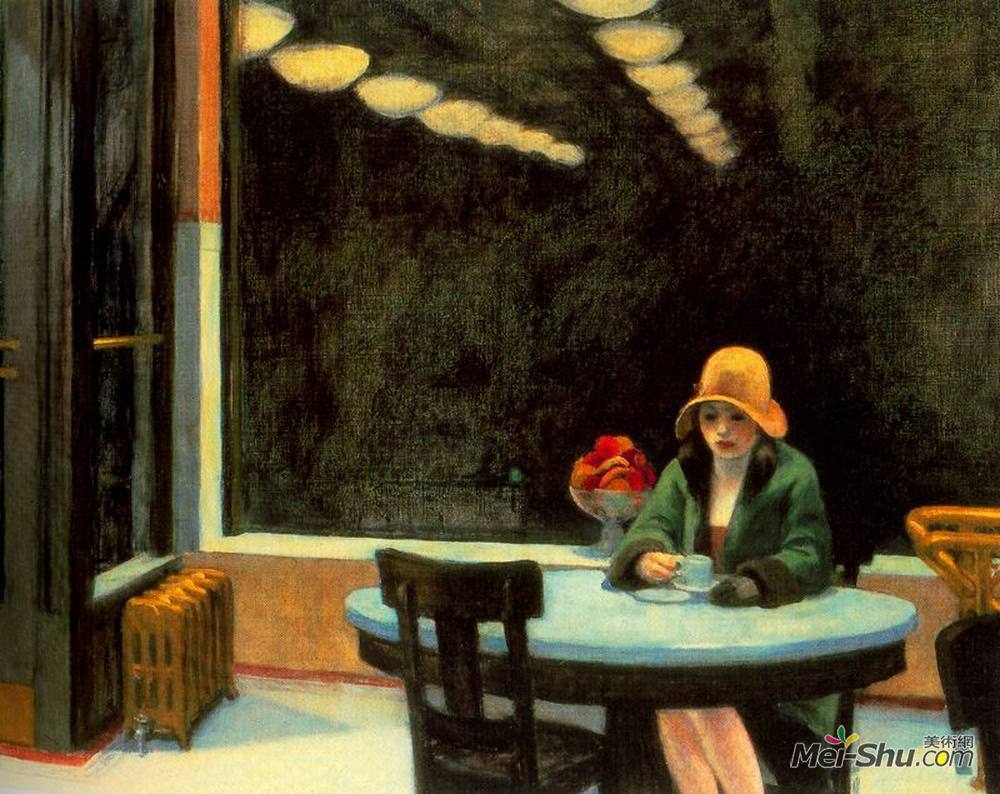 爱德华·霍普(Edward Hopper)高清作品《自动售货机》
爱德华·霍普(Edward Hopper)高清作品《自动售货机》
作品名:自动售货机
艺术家:爱德华·霍普
年代:1927
风格:新现实主义
类型:风俗画
材质:布面油彩
标签:家具和装饰,咖啡馆和餐馆
尺寸:91.4 X 71.4厘米
这幅画描绘了一个孤独的女人晚上在自动售货机里凝视着一杯咖啡。一排排灯具的倒影从漆黑的窗户伸出来。霍珀的妻子乔成了这个女人的模特。然而,霍珀改变了她的容貌,使她年轻(Jo是44在1927)。他还改变了她的身材;乔是一个曲线优美、身材丰满的女人,而一位评论家则形容这幅画中的女人是“男孩子气”(即,平胸)。“正如霍珀的画中经常出现的情况,这个女人的情境和她的情绪都是模棱两可的。”她穿着考究,化着妆,这可能表明她在去上班的路上或下班的路上,在个人外表很重要的工作,或者她正在去社交场合的路上。她很匆忙,只能停留片刻,或者简单地说她刚从外面进来,还没有暖和起来。但是后一种可能性似乎不太可能,因为在她的杯子和碟子前面的桌子上有一个小的空盘子,表明她可能已经吃了点心,坐在这个地方有一段时间了。
Title:Automat
artist:Edward Hopper
Date:1927
Style:New Realism
Genre:genre painting
Media:oil,canvas
Tag:furniture-and-decoration,cafes-and-restaurants
Dimensions:91.4 x 71.4 cm
The painting portrays a lone woman staring into a cup of coffee in an Automat at night. The reflection of identical rows of light fixtures stretches out through the night-blackened window.Hopper's wife, Jo, served as the model for the woman. However, Hopper altered her face to make her younger (Jo was 44 in 1927). He also altered her figure; Jo was a curvy, full-figured woman, while one critic has described the woman in the painting as "'boyish' (that is, flat-chested)" As is often the case in Hopper's paintings, both the woman's circumstances and her mood are ambiguous. She is well-dressed and is wearing makeup, which could indicate either that she is on her way to or from work at a job where personal appearance is important, or that she is on her way to or from a social occasion.She has removed only one glove, which may indicate either that she is distracted, that she is in a hurry and can stop only for a moment, or simply that she has just come in from outside, and has not yet warmed up. But the latter possibility seems unlikely, for there is a small empty plate on the table, in front of her cup and saucer, suggesting that she may have eaten a snack and been sitting at this spot for some time.
作品名称:《自动售货机》爱德华·霍普(Edward Hopper)高清作品欣赏
作品链接:https://www.mei-shu.com/famous/26124/artistic-60937.html
作品类别:油画
免责声明:本站部分公开资料来源于互联网,目的是用于学术交流与讨论,并不代表本网赞同其观点和对其真实性负责。如果您认为我们的侵犯了您的权益,请与我们联系(banquan#mei-shu.com #替换为@),我们将在第一时间删除相关内容。